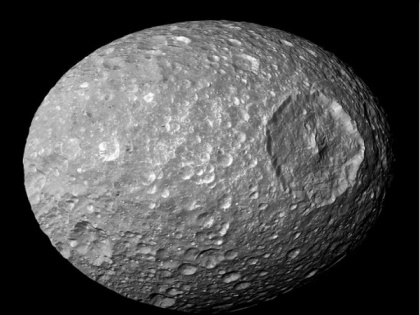Inner complexity in Saturn moon 'Enceladus' hints at habitable conditions
By ANI | Published: January 23, 2020 08:46 AM2020-01-23T08:46:29+5:302020-01-23T09:00:07+5:30
A new geochemical model has been developed by a Southwest Research Institute team, that reveals that carbon dioxide (CO2) from within Enceladus, an ocean-harbouring moon of Saturn, may be controlled by chemical reactions at its seafloor.

Inner complexity in Saturn moon 'Enceladus' hints at habitable conditions
A new geochemical model has been developed by a Southwest Research Institute team, that reveals that carbon dioxide (CO2) from within Enceladus, an ocean-harbouring moon of Saturn, may be controlled by chemical reactions at its seafloor.
A study of the plume of gases and frozen sea spray released through cracks in the moon's icy surface suggests an interior more complex than previously thought.
SwRI's Dr. Christopher Glein, lead author of a paper in Geophysical Research Letters outlining the research said: "By understanding the composition of the plume, we can learn about what the ocean is like, how it got to be this way and whether it provides environments where life as we know it could survive,"
He further said: "We came up with a new technique for analyzing the plume composition to estimate the concentration of dissolved CO2 in the ocean. This enabled modelling to probe deeper interior processes."
Taken an analysis of the NASA's Cassini spacecraft's mass spectrometry data, it showcased an indication that the abundance of CO2 is best explained by geochemical reactions between the moon's rocky core and liquid water from its subsurface ocean.
Integrating this information with previous discoveries of silica and molecular hydrogen (H2) points to a more complex, geochemically diverse core.
Glein said that "Based on our findings, Enceladus appears to demonstrate a massive carbon sequestration experiment."
"On Earth, climate scientists are exploring whether a similar process can be utilized to mitigate industrial emissions of CO2. Using two different data sets, we derived CO2 concentration ranges that are intriguingly similar to what would be expected from the dissolution and formation of certain mixtures of silicon- and carbon-bearing minerals at the seafloor," Glein added.
The likely presence of hydrothermal vents inside Enceladus could be seen as another phenomenon that contributes to this.
At Earth's ocean floor, hydrothermal vents emit hot, energy-rich, mineral-laden fluids that allow unique ecosystems teeming with unusual creatures to thrive.
SwRI's Dr. Hunter Waite, principal investigator of Cassini's Ion Neutral Mass Spectrometer (INMS) said that "The dynamic interface of a complex core and seawater could potentially create energy sources that might support life."
"While we have not found evidence of the presence of microbial life in the ocean of Enceladus, the growing evidence for chemical disequilibrium offers a tantalizing hint that habitable conditions could exist beneath the moon's icy crust."
The scientific community continues reaping the benefits of Cassini's close flyby of Enceladus on Oct. 28, 2015, prior to the end of the mission. INMS detected H2 as the spacecraft flew through the plume, and a different instrument had earlier detected tiny particles of silica, two chemicals that are considered to be markers for hydrothermal processes.
Glein said: "Distinct sources of observed CO2, silica and H2 imply mineralogically and thermally diverse environments in a heterogeneous rocky core."
"We suggest that the core is composed of a carbonated upper layer and a serpentinized interior," he further stated.
Carbonates usually occur as sedimentary rocks such as limestone on Earth, while serpentine minerals are formed from igneous seafloor rocks that are rich in magnesium and iron.
Such rocks also have the potential to influence the CO2 chemistry of the ocean via low-temperature reactions involving silicates and carbonates at the seafloor.
Talking of the model they have suggested with, Glein said: "This model could explain how planetary differentiation and alteration processes create chemical (energy) gradients needed by subsurface life."
( With inputs from ANI )
Open in app